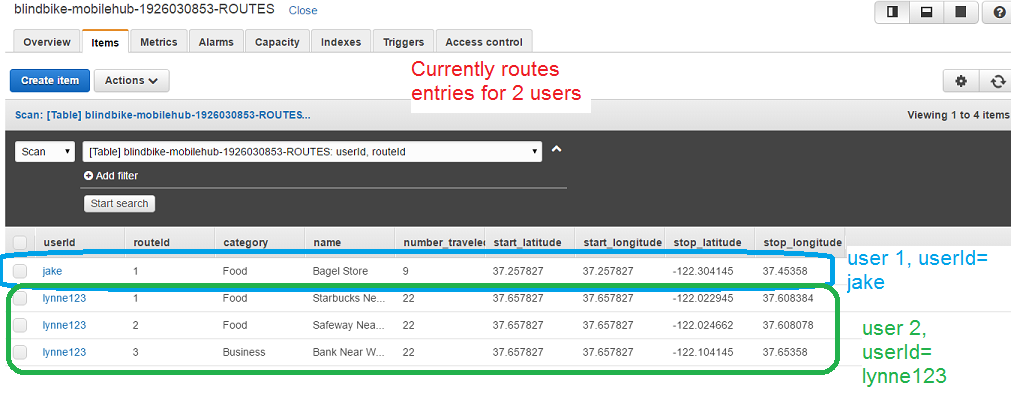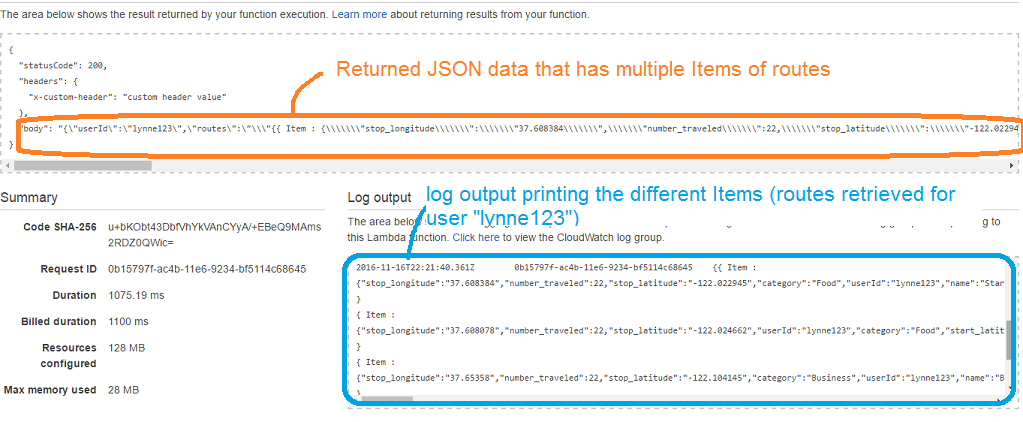CS4521: Mobile and Topics in Web Programming |
||||||
|
Lambda (nodeJS) funciton code for retrieve of multiple routes entries in ROUTES database table-- this code will
- //STEP 0: setup use of AWS DocumentClient class
- //STEP 1: make a request from database table ROUTES, to get all entries associated with input userId specified
- //STEP 2: cycle through each returned entry/item in the ROUTES table building out a JSON response
- //STEP 3:return JSON wrapped results
First: Have a database table called ROUTES that contain routes
-
primary key - userId , routeId
-
other columns - name, category, number_traveled, start_longitude, start_latitude, stop_longitude, stop_latitude
Code
special note: uses the AWS class DocumentClient
'use strict'; /* This code is used to grab the 10 most popolar entries into the Database of ROUTES for blindBike. To make this request the input to this program must contain the userId so can grab only ROUTES associated with that user. Notice that the format is JSON (java script object notation) which is commonly used for data exchange with web services
*/
console.log('Loading function');
var doc = require('dynamodb-doc'); //require javascript package for DynamoDB access
var db = new doc.DynamoDB(); //create instance of DynamoDB access object
var AWS = require("aws-sdk");
var docClient = new AWS.DynamoDB.DocumentClient();//NEW using this for multiple item requests
console.log('Loaded Database Object');
exports.handler = function(event, context, callback) {
var responseCode = 200;
var requestBody, pathParams, queryStringParams, headerParams, stage,
stageVariables, cognitoIdentityId, httpMethod, sourceIp, userAgent,
requestId, resourcePath;
console.log("request: " + JSON.stringify(event));
// Request Body requestBody = event.body; if (requestBody !== undefined && requestBody !== null) {
// Set 'test-status' field in the request to test sending a specific response status code (e.g., 503) responseCode = JSON.parse(requestBody)['test-status']; } // Path Parameters pathParams = event.path; // Query String Parameters queryStringParams = event.queryStringParameters; // Header Parameters headerParams = event.headers; if (event.requestContext !== null && event.requestContext !== undefined) {
var requestContext = event.requestContext;
// API Gateway Stage
stage = requestContext.stage;
// Unique Request ID requestId = requestContext.requestId; // Resource Path resourcePath = requestContext.resourcePath; var identity = requestContext.identity; // Amazon Cognito User Identity cognitoIdentityId = identity.cognitoIdentityId; // Source IP sourceIp = identity.sourceIp; // User-Agent userAgent = identity.userAgent; } // API Gateway Stage Variables stageVariables = event.stageVariables; // HTTP Method (e.g., POST, GET, HEAD) httpMethod = event.httpMethod; //********************************************************************************************
//business logic --read in input and create new user entry in biker table
var userId ; //get userID from event
//IF a PUT method get the JSON data from body and not from event
if(httpMethod !== undefined && (httpMethod == "PUT" || httpMethod =="POST"))
{ requestBody = JSON.parse(requestBody); //expect input in JSON form
userId = requestBody.userId;
console.log("POST request with userid=" + userId + " and method type = " + httpMethod + "and requestBody= " + JSON.stringify(requestBody));
}
else if(httpMethod !== undefined && httpMethod == "GET") //if GET method type
{
console.log("Get parameter data: " + JSON.stringify(queryStringParams));
userId = queryStringParams.userId;
console.log("userid INPUT" + userId + " and method type = " + httpMethod + "and queryParameters= " + JSON.stringify(queryStringParams));
}
else //if not post
{
userId = event.userId; //get userID from event
console.log("INSIDE non POST request with userId= " + userId + " and method type = " + httpMethod + "and event= " + JSON.stringify(event));
}
//simple log to see what is going on.
console.log(userId);
var tableName = "blindbike-mobilehub-1926030853-ROUTES"; //this is the name of YOUR project's dynamoDB table
//make request to get the entry from database table with the
// above key specified for user id in the params variable
//*******Using query method of DocumentClient in AWS api
var params2 = {
TableName:tableName,
KeyConditionExpression: "#uid = :value",
ExpressionAttributeNames:{
"#uid": "userId"
},
ExpressionAttributeValues: {
":value":userId
}
};
console.log("params" + params2);
docClient.query(params2, function(err, data) {
if (err) {
console.error("Unable to query. Error:", JSON.stringify(err, null, 2));
} else {
console.log("Query succeeded.");
console.log("data" + data);
//*******************************************************************************
// For demonstration purposes, we'll just echo these values back to the client
var routes = "{";
var print_Routes = routes;
// Cylce through each item retrieved from the Table using params2 query
data.Items.forEach(function(item) {
console.log(" -", item.name + ": " + item.userId);
routes += "{ Item : " + JSON.stringify(item) + " } ";
print_Routes += "{ Item :\n" + JSON.stringify(item) + "\n}\n";
});
routes += " }"
console.log(routes); // successful response
console.log(print_Routes);
var responseBody = {
requestBody : requestBody,
pathParams : pathParams,
queryStringParams : queryStringParams,
headerParams : headerParams,
stage : stage,
stageVariables : stageVariables,
cognitoIdentityId : cognitoIdentityId,
httpMethod : httpMethod,
sourceIp : sourceIp,
userAgent : userAgent,
requestId : requestId,
resourcePath : resourcePath,
userId: userId,
routes: JSON.stringify(routes)
};
var response = {
statusCode: responseCode,
headers: {
"x-custom-header" : "custom header value"
},
body: JSON.stringify(responseBody)
};
console.log("response: " + JSON.stringify(response))
context.succeed(response);
callback(JSON.stringify(response));
}
});
console.log(params); }; |
Results
we see output as JSON response and LOG shows print out of the multiple routes for user "lynne123" presented as Item JSON formated objects

